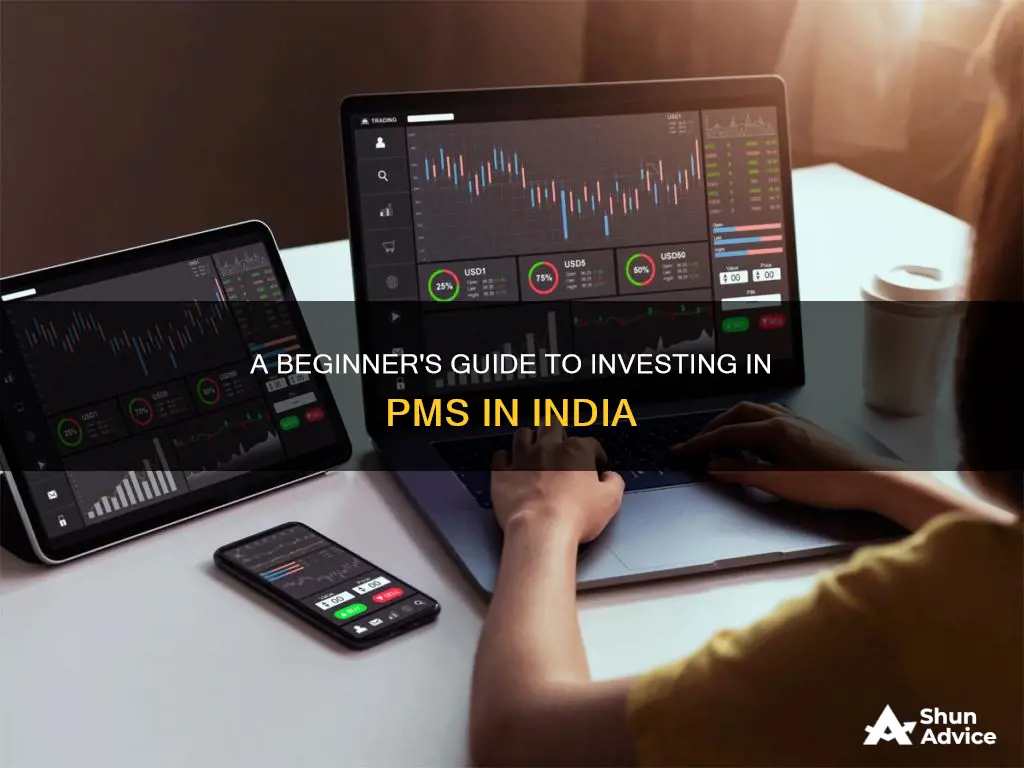
Portfolio Management Services (PMS) is a licensed and professional investment service that offers tailored investment strategies to high net worth individuals (HNIs) and institutions. With a minimum investment requirement of 50 lakhs, PMS provides access to a dedicated portfolio manager who offers insights, customisation, and timely adjustments based on market conditions and client objectives. PMS providers invest on behalf of their clients in a diverse range of asset classes, including stocks, bonds, mutual funds, and other securities. They charge an annual management fee, typically a percentage of the assets under management (AUM), and may also charge performance fees. When investing in PMS in India, it is essential to conduct thorough research, evaluate your financial goals and risk tolerance, and select a reputable provider that aligns with your investment objectives.
| Characteristics | Values |
|---|---|
| Minimum Investment | Rs 50 lakhs |
| Management Fees | 1-3% of AUM |
| Performance Fees | Percentage of profits above a predefined hurdle rate |
| Investment Options | Equity, debt, derivatives, and other asset classes |
| Investment Philosophy | Value investing, growth investing, income investing, and quantitative investing |
| Types | Discretionary, non-discretionary, and advisory services |
What You'll Learn

How to choose the best PMS provider
When choosing a Portfolio Management Service (PMS) provider in India, it is essential to conduct a comprehensive evaluation of both objective and qualitative criteria to ensure alignment with your financial goals, risk tolerance, and investment philosophy. Here are some key factors to consider when selecting the best PMS provider:
Level 1 (Basic) Criteria:
- SEBI Registration: Ensure that the PMS provider is registered with the Securities and Exchange Board of India (SEBI), the regulatory body overseeing PMS providers in the country. You can verify their registration on the SEBI website.
- Experience: Look for a PMS provider with significant experience in the industry, ideally with at least five years of tenure managing actual client funds. This demonstrates their ability to navigate different market cycles and provide consistent returns.
- Minimum Investment Requirement: The SEBI-specified minimum investment for PMS per client is ₹50 lakhs, but some providers may have a higher threshold. Ensure that the required investment aligns with your available capital.
- Management and Performance Fees: Understand the fee structure, including management fees (typically a percentage of assets under management) and performance fees (a percentage of profits above a predefined rate). Evaluate whether the fees align with the value provided and your expectations.
- Performance Track Record (Level 1): Review the PMS provider's historical performance over various time frames (1-year, 3-year, and 5-year). Compare these returns with relevant benchmarks like Nifty 50, BSE Sensex, or Nifty500 to assess their ability to generate excess returns.
Level 2 (Advanced) Criteria:
- Performance Track Record (Level 2): Evaluate the PMS provider's performance using rolling returns instead of point-to-point returns. This will show how the investment has performed over time relative to its benchmark. Look for consistent performance and a higher percentage of returns compared to the benchmark.
- Consistency: Assess the PMS provider's ability to deliver returns across different market cycles. Look for metrics such as Upside and Downside Capture Ratios, Sharpe Ratio, and Sortino Ratio to gauge their performance in both bullish and bearish markets.
- Volatility Measures: Analyze the portfolio's volatility using standard deviation and the Sortino ratio, which measures downside variability. This will help you understand the risk-adjusted returns and whether the PMS tends to lose more or less money than the benchmark during unfavourable market conditions.
- Drawdown Control: Evaluate how effectively the PMS provider manages drawdowns (peak-to-trough declines) to protect your investment during market downturns. Assess their performance during significant market corrections to ensure they can navigate challenging periods.
- Alignment with Investment Philosophy: Ensure that the PMS provider's investment philosophy aligns with your own beliefs and long-term investment goals. This alignment will help you stay invested for the long term, even during periods of underperformance.
- Reputation and Credibility: Look beyond marketing and media presence. Seek independent viewpoints, and assess whether they provide balanced views and transparent communication. Sign up for their newsletter, follow their social media, and take the time to form an informed opinion.
- Flexibility, Client Service, and Support: Choose a PMS provider that offers tailored investment strategies based on your financial goals and risk appetite. Ensure they provide regular updates, detailed reports, and responsive client support.
- Reporting Standards: Opt for a PMS provider that offers transparent and detailed reporting on portfolio composition, transactions, and performance. Request sample reports and walk through their client dashboard to understand the level of transparency they provide.
- Fee Transparency: Ensure that the fee structure is clear and fully disclosed, with no hidden charges. This allows for a proper evaluation of the net returns and helps you make informed decisions.
Additional Considerations:
- Shortlist and Interview: Create a shortlist of PMS providers based on the Level 1 criteria and then apply the Level 2 criteria to further evaluate them. Arrange meetings with portfolio managers or representatives to discuss their investment philosophy, strategies, and alignment with your financial goals.
- Review Sample Reports: Request and assess sample reports from the shortlisted PMS providers to gauge the clarity, detail, and frequency of their reporting. Transparency in reporting is crucial for effectively monitoring your investments.
- Make an Informed Decision: Based on your comprehensive analysis and consultations, select the PMS provider that best aligns with your investment goals, risk tolerance, and preferences. Ensure you thoroughly understand the terms and conditions before committing.
Breaking Up with Your Investment Manager: A Guide
You may want to see also

Understanding the risks
Market Risk:
PMS investments are susceptible to market risks, meaning that the value of the investments can fluctuate with market conditions. A market downturn could lead to a decline in the value of the portfolio, resulting in losses. It is important to remember that past performance does not guarantee future results.
Concentration Risk:
PMS providers may concentrate a significant portion of the portfolio in specific sectors, asset classes, or securities. This concentration risk can amplify the impact of adverse events related to those holdings, potentially leading to higher volatility and losses. It is advisable to diversify the portfolio to manage this risk effectively.
Manager Risk:
The performance of the PMS investment relies heavily on the expertise and decision-making skills of the portfolio manager. Manager risk refers to the possibility that the manager's investment decisions may not yield the desired outcomes. Therefore, evaluating the track record and experience of the portfolio manager is crucial before investing.
Liquidity Risk:
Some PMS investments may be illiquid, making it challenging to sell them quickly in the market. This can create issues if investors need to liquidate their investments to meet financial obligations. It is important to assess the liquidity profile of the investments within the PMS strategy.
Operational Risk:
Operational risk pertains to potential errors in trade execution, data management, compliance, or internal control failures by the PMS provider. These operational risks can lead to financial losses for investors. Therefore, thoroughly evaluating the operational capabilities and infrastructure of the PMS provider is essential for mitigating such risks.
Regulatory Risk:
Changes in regulations, tax policies, or legal frameworks can impact the functioning and returns of PMS investments. PMS providers in India are regulated by the Securities and Exchange Board of India (SEBI), and investors should stay informed about the regulatory landscape to understand its potential effects on their investment strategy.
It is important to carefully consider these risks and their potential impact on investment objectives before deciding to invest in a PMS. Conducting thorough due diligence, assessing the reputation and expertise of portfolio managers, and ensuring transparency and regulatory compliance are essential steps in the decision-making process.
Relationship Managers: Investment Firms' Key to Client Success
You may want to see also

The benefits of PMS
Portfolio Management Services (PMS) offer a range of benefits for Ultra High Net Worth Individuals (UHNIs) looking for personalised and tailored investment solutions. Here are some of the key advantages of investing in a PMS in India:
Customised Portfolio
PMS provides UHNIs with a personalised investment portfolio designed to align with their specific financial goals, risk tolerance, and investment preferences. The portfolio is managed by experienced professionals who adapt the strategy based on changing market conditions and individual requirements.
Direct Ownership of Securities
Unlike mutual funds, where investors hold units, PMS investors have direct ownership of the securities in their portfolio. This allows greater transparency and control over the underlying investments. UHNIs can choose to include or exclude specific stocks or sectors based on their investment outlook.
Tailored Investment Strategies
PMS providers offer a range of investment strategies to cater to the diverse needs of UHNIs. Whether it's long-term wealth creation, capital preservation, income generation, or a combination of these objectives, PMS allows customisation of investment strategies to suit individual goals.
Access to Expertise
PMS investors benefit from the expertise of professional fund managers who have a deep understanding of the market and possess the skills to make informed investment decisions. These managers conduct extensive research, analysis, and due diligence to identify potential investment opportunities and manage risks effectively.
Direct Communication and Transparency
UHNIs investing in PMS enjoy direct communication with the fund manager, enabling them to gain insights into the investment process, portfolio composition, and performance updates. This transparency allows investors to have a better understanding of their investments and make informed decisions.
Flexibility and Agility
PMS offers flexibility in terms of investment options, including equity, debt, derivatives, and other asset classes. This allows UHNIs to capitalise on market opportunities and adapt their portfolios based on changing market conditions or personal circumstances.
Estate Planning and Succession
PMS providers often offer specialised services for estate planning and succession, crucial for UHNIs looking to preserve and transfer wealth to future generations. These services help in structuring investments and implementing strategies to ensure a smooth transition of assets.
Tilt Your Investment Portfolio: Value and Small-Cap Focus
You may want to see also

PMS vs Mutual Funds
Portfolio Management Services (PMS) and Mutual Funds (MF) are both avenues for investing in stocks or bonds. However, there are several differences between the two that investors should consider before choosing which option is best for them. This article will outline and compare the features of PMS and MF, including the types of investors they cater to, the investment process, fees and charges, risk factors, and tax implications, to provide a comprehensive overview of PMS vs MF in India.
Types of Investors
PMS is typically suited for high-net-worth individuals (HNIs) and institutions due to its high minimum investment requirement, often starting at Rs 25-50 lakhs. On the other hand, MFs cater to a much wider range of investors, allowing individuals to start investing with a nominal amount of as little as Rs 500.
Investment Process
PMS offers personalized investment strategies tailored to meet specific financial goals and risk preferences. Investors benefit from the expertise of professional portfolio managers who manage their investment portfolios on their behalf. PMS provides flexibility in investment options, including equity, debt, derivatives, and other asset classes. There are two main types of PMS: discretionary, where the portfolio manager independently manages the funds; and non-discretionary, where the manager executes trades according to the client's directions.
MFs, on the other hand, are professionally-managed investment schemes run by an asset management company (AMC). MFs pool together a group of investors and invest their money in various instruments/assets based on a common investment objective. MFs offer a wider range of investment options that cater to different risk profiles.
Fees and Charges
PMS charges a higher fee for portfolio management compared to MFs. PMS fees include entry load, fund management charges, and sometimes profit sharing or fixed fees. MFs, on the other hand, have minimal expense ratios and exit loads, making them more cost-effective.
Risk Factors
MFs offer various options and diversification, making them suitable for investors with different risk appetites. In comparison, PMS investments are generally riskier as they usually hold a concentrated portfolio of 20-30 stocks. PMS investments are subject to higher market risks and volatility, and they do not have the regulatory restrictions that MFs have on derivative instruments.
Tax Implications
PMS and MFs differ in their tax implications. In PMS, capital gains are computed on each underlying transaction, and trades conducted by the portfolio manager reflect in the investor's Demat account, impacting their tax incidence. MFs, on the other hand, are registered as tax-exempt trust structures. In MFs, tax implications arise only when an investor exits the fund, and there is no tax liability for transactions made by the fund manager.
PMS and MFs offer different features and cater to diverse investor needs. While PMS provides personalized investment strategies and flexibility, it comes with higher fees, risk, and tax implications. MFs, on the other hand, offer simplicity, a wider range of investment options, lower fees, and better tax efficiency. Small investors and those seeking a more diversified and regulated investment option may find MFs more suitable, while PMS may be more appropriate for HNIs seeking tailored investment strategies.
Waste Management: A Guide to Smart Investing
You may want to see also

How PMS works
How Portfolio Management Services (PMS) Work
Client Onboarding
The PMS provider initiates the process by understanding the client's investment objectives, risk tolerance, and financial goals. Necessary documents such as PAN card, KYC details, and investment declaration forms are collected.
Portfolio Construction
Based on the client's goals and risk appetite, the PMS provider constructs a tailored portfolio. This includes a mix of asset classes like equity, debt, and others, taking into consideration the client's preferences, investment horizon, and liquidity needs.
Investment Execution
The PMS provider executes the investment strategy by buying and selling securities in the market. They use various techniques like fundamental analysis, technical analysis, and quantitative analysis to make investment decisions.
Monitoring and Rebalancing
The PMS provider continuously monitors the portfolio's performance, making adjustments to maintain the desired asset allocation and risk profile. They may rebalance the portfolio periodically to ensure it aligns with the client's objectives and risk tolerance.
Reporting and Communication
The PMS provider regularly updates the client on their portfolio's performance, including its value, returns generated, and any changes to the investment strategy. They also communicate market events and investment decisions that may impact the portfolio.
Fees and Charges
PMS providers charge fees for their services, typically including management fees, performance fees, and other charges. The fee structure may vary depending on the provider and the type of service offered.
A Beginner's Guide to Investing in India's AI Future
You may want to see also
Frequently asked questions
The Securities and Exchange Board of India (SEBI) has set a minimum investment amount of Rs. 50 lakhs for individuals to be eligible for PMS services. However, some PMS providers may have a higher threshold depending on their target clientele.
PMS offers several benefits such as customized portfolios, direct ownership of securities, access to expert fund managers, flexibility in investment options, and estate planning and succession services. PMS also provides high-level transparency with detailed reports on portfolio allocation, performance, and market outlook.
When choosing a PMS provider, it is essential to consider factors such as their reputation, investment philosophy, fees, transparency, regulatory compliance, and service quality. Conduct thorough research, evaluate their track record, and ensure that they are registered with SEBI.







